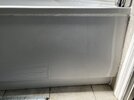A year ago I had a replacement bathroom. Supply was done by fitter’s preferred supplier but I hadn’t realised at the time they treated supply as to me directly (I deliberately picked a fitter that said they offer supply + fit) so the fitter isn’t interested in coming back to look at issues.
I’ve had a few issues with the fit, mostly resolved, but the one I can’t seem to figure out is the bath panel. I deliberately went for a basic flexible bath panel as reason it all needed replacing was due to a slow leak over many years behind a fixed tiled panel so I wanted to be able to take it off easily to check. However I have a steel bath and water was getting into the “lip” between the panel and the bath and creating rust underneath the bath. It appears there is a bit of the bath “lip” that isn’t covered and so is bare steel. I’ve tried to fix this by jamming silicone into the gap but the kids have knocked the panel as you would expect and it’s come loose. Any suggestions? Do I need a new panel or is there anything I can do to prevent the rusting issue?
I’m not fussed about the look of it (my shoddy silicone!) but don’t want the rust!
I’ve had a few issues with the fit, mostly resolved, but the one I can’t seem to figure out is the bath panel. I deliberately went for a basic flexible bath panel as reason it all needed replacing was due to a slow leak over many years behind a fixed tiled panel so I wanted to be able to take it off easily to check. However I have a steel bath and water was getting into the “lip” between the panel and the bath and creating rust underneath the bath. It appears there is a bit of the bath “lip” that isn’t covered and so is bare steel. I’ve tried to fix this by jamming silicone into the gap but the kids have knocked the panel as you would expect and it’s come loose. Any suggestions? Do I need a new panel or is there anything I can do to prevent the rusting issue?
I’m not fussed about the look of it (my shoddy silicone!) but don’t want the rust!


